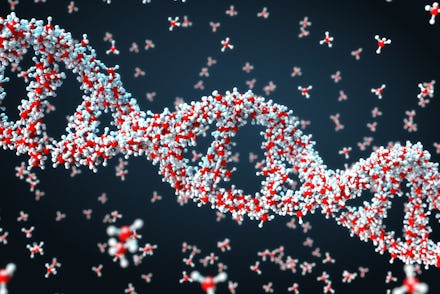Scientists Have Created Alien DNA in a Lab

The news: A team of researchers in California have finally done what we've all been waiting for: discovered alien life. Well, technically, they've created an organism whose genetic code has six 'letters' (the nucleobases of DNA) rather than the familiar four, which, in layman's terms, means they've developed the first life with "alien" DNA. The new "semi-synthetic organism" (a bacterium) produced by the team is the first known life form to contain artificial genetic building blocks.
To do so, these researchers have basically expanded the genetic alphabet. Nucleotides are molecules that bind together to comprise the DNA double helix, normally represented by the letters G, A, T and C. The Scripps Research Institute scientists managed to add a single pair of completely artificial X and Y nucleotides to the genes of a strain of E. coli, and the organism appears to be reproducing and functioning naturally.
"What we have now is a living cell that literally stores increased genetic information," wrote chemical biologist and lead researcher Floyd Romesberg in Nature. He also said the new code will allow researchers to "write more words and tell more stories," creating new proteins and life forms.
The implications are vast: Potential uses include the incorporation of a toxic amino acid into a protein to target kill cancer cells, or glowing amino acids that help scientists study cellular reactions. And future semi-synthetic organisms could have broad uses ranging from fighting disease to boosting the immune system. While their lab-created strain of E. coli isn't capable of producing "novel proteins" – protiens that are genetically modified to perform a certain function – this just means further work needs to be done before organisms genetically engineered in this way can produce new drugs or vaccines.
Many scientists are optimistic. Stanford chemistry professor Eric T. Kool told the New York Times that "it is clear that the day is coming that we’ll have stably replicating unnatural genetic structures."
Scientific American explains how the process works:
The first challenge to creating this alien life was to get cells to accept the foreign bases needed to maintain the molecule in DNA through repeated rounds of cell division, during which DNA is copied. The team engineered the bacterium Escherichia coli to express a gene from a diatom — a single-celled alga — encoding a protein that allowed the molecules to pass through the bacterium's membrane.The scientists then created a short loop of DNA, called a plasmid, containing a single pair of the foreign bases, and inserted the whole thing into E. coli cells. With the diatom protein supplying a diet of foreign nucleotides, the plasmid was copied and passed on to dividing E. coli cells for nearly a week. When the supply of foreign nucleotides ran out, the bacteria replaced the foreign bases with natural ones.
Backlash: It's an exciting breakthrough, but not everyone is a fan.
"The arrival of this unprecedented 'alien' life form could in time have far-reaching ethical, legal and regulatory implications," said Jim Thomas of the Canadian-based ETC Group, an advocacy organization. "While synthetic biologists invent new ways to monkey with the fundamentals of life, governments haven't even been able to cobble together the basics of oversight, assessment or regulation for this surging field."
If you're worried about this life replicating in the field with unknown consequences, rest easy. The introduction of synthetic genetic information also means that the strain of E. coli created in the lab is totally dependent on synthetic molecules to replicate — meaning it would quickly die in the wild. But isn't that what the creators of Jurassic Park said?